You’ll transform your architectural presentations with content libraries that deliver real-time rendering at 60+ FPS while providing access to diverse furniture, appliances, and PBR materials. These systems integrate seamlessly with major 3D modeling software and VR tools like SketchUp VR and Enscape, enabling instant visual feedback and immersive walkthroughs. Unity and Unreal Engine guarantee cross-platform compatibility with photorealistic lighting and textures that maintain consistent performance across desktop, mobile, and VR devices for enhanced client engagement and decision-making.
Real-Time Rendering Capabilities and Workflow Integration
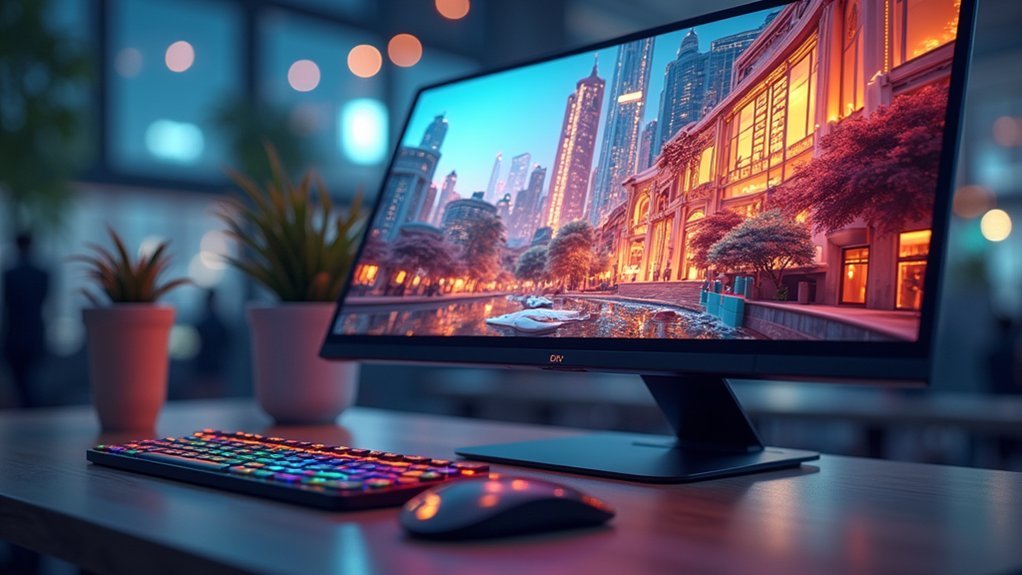
While traditional rendering methods once required hours or even days to produce a single high-quality image, real-time rendering has revolutionized architectural visualization by delivering instant visual feedback the moment you modify your design.
This technology seamlessly integrates with major 3D modeling software, converting your CAD or BIM designs into photorealistic visuals within minutes.
You’ll benefit from rapid iterations that foster dynamic design processes, making quick modifications while evaluating their visual impact immediately.
Real-time rendering enhances collaboration through high-resolution outputs that accurately convey intricate details and lighting.
Real-time rendering delivers high-resolution visuals that capture precise details and lighting, transforming how teams collaborate on architectural projects.
When combined with VR technology, you can create immersive experiences that enable stakeholders to engage with film-quality videos and interactive presentations, elevating overall design understanding.
Comprehensive 3D Asset Libraries and Material Collections
Beyond rendering speed, your visualization quality depends heavily on the richness and authenticity of your extensive 3D asset libraries and material collections.
These resources transform basic architectural models into compelling, lifelike environments that engage clients and stakeholders.
Your material collections from providers like Poliigon and ShareTexture deliver high-quality PBR materials that accurately simulate real-world textures and finishes.
Combined with optimized objects such as SpeedTree vegetation and animated vehicles, you’ll create truly immersive experiences that showcase your design intent.
Key benefits of extensive asset libraries include:
- Access to furniture, appliances, and dynamic 3D people for authentic spatial context
- Rapid customization capabilities for precise design vision alignment
- Streamlined workflows enabling faster iterations without quality compromise
- Enhanced realism through professionally optimized environmental elements
Virtual Reality Tools for Immersive Design Presentations
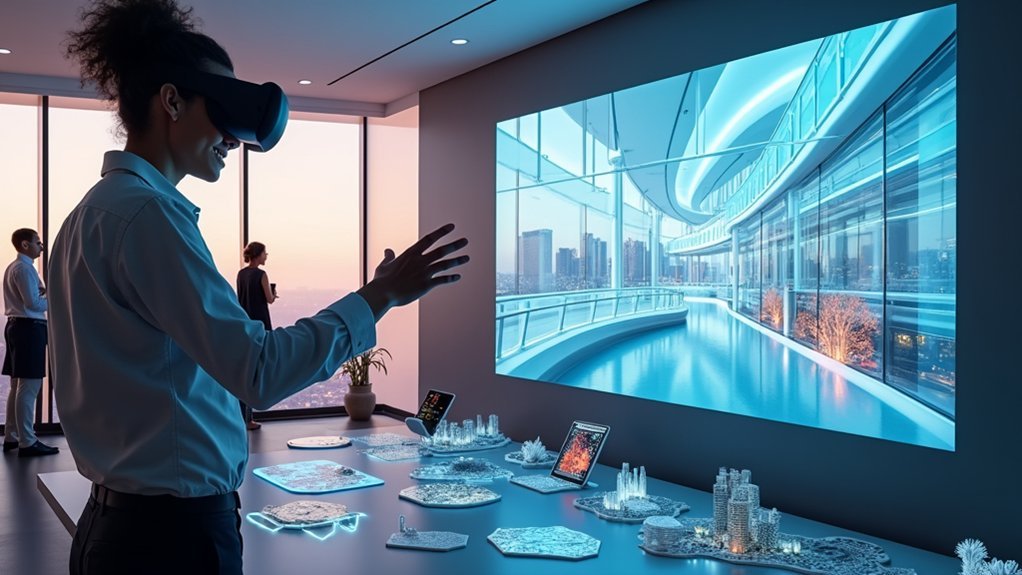
As architectural design evolves into increasingly interactive experiences, virtual reality tools revolutionize how you present concepts to clients and stakeholders. SketchUp VR and Enscape enable immersive design presentations where clients virtually walk through spaces, experiencing design elements in real-time. These VR experiences enhance collaborative feedback during reviews, allowing immediate adjustments regardless of location.
| VR Tool | Primary Function | Key Feature |
|---|---|---|
| SketchUp VR | Design Creation | Real-time walkthroughs |
| Enscape | Visualization | Live rendering |
| IrisVR | Model Conversion | Seamless integration |
| Twinmotion | Interactive Environments | Quick conversion |
| Unity/Unreal | High-quality Rendering | Realistic materials |
Tools like Unity and Unreal Engine provide realistic lighting and textures for impactful presentations. IrisVR and Twinmotion streamline converting 3D models into interactive experiences, markedly reducing design-to-presentation time through seamless integration.
Cross-Platform Development Kits and Unity Engine Support
When architectural visualization projects demand deployment across multiple platforms, Unity Engine’s development kits provide the foundational tools you need to create seamless cross-platform experiences. These specialized kits enable you to integrate architectural assets efficiently while maintaining compatibility across diverse platforms and Unity versions.
The in-editor emulator transforms your design process by simulating projector arrays, letting you preview immersive visualizations before real-world implementation. You’ll streamline VR projects through remote development capabilities, eliminating the need for on-site work and accelerating project timelines.
- Cross-platform compatibility guarantees your architectural visualizations work seamlessly across multiple devices and operating systems
- In-editor emulation tools simulate complex projection systems for accurate preview capabilities
- Remote development support enables off-site collaboration and reduces geographical constraints
- Future-proof architecture maintains compatibility with evolving Unity versions and industry standards
Collaborative Design Features and Multi-User Environments
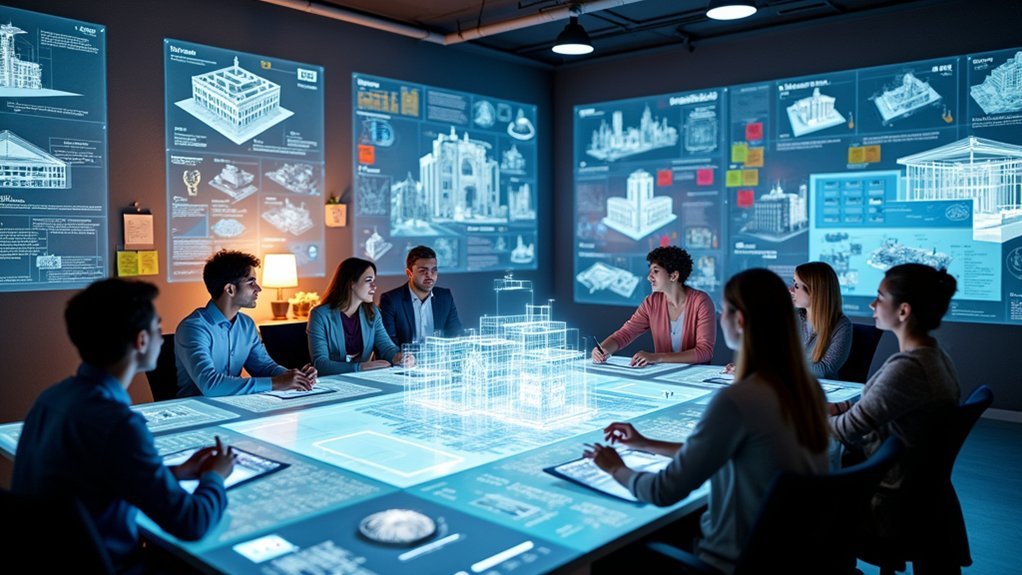
How do you transform isolated design reviews into dynamic, interactive experiences where every stakeholder contributes meaningfully?
Collaborative design features in VR revolutionize how teams work together by enabling multiple stakeholders to interact with 3D models simultaneously. You’ll facilitate real-time feedback and decision-making that keeps projects moving forward efficiently.
Multi-user environments enhance engagement by allowing architects, clients, and team members to explore designs together, creating a truly inclusive experience.
Tools like AiHouse Visioneer enable on-the-fly adjustments in virtual models, fostering seamless collaboration while ensuring every voice is heard. You’ll implement instant visual changes during sessions, streamlining workflows and reducing revision time.
These platforms greatly enhance project outcomes by promoting shared understanding and encouraging creative input from diverse perspectives.
Performance Optimization and Quality Enhancement Technologies
You’ll need robust performance optimization technologies to deliver smooth, high-quality architectural visualizations that meet professional standards.
Real-time rendering acceleration through techniques like InstancedMesh and BufferGeometry can dramatically boost your frame rates while reducing memory overhead by up to 80%.
Your content library’s success depends on seamless asset optimization and cross-platform engine integration that guarantees consistent performance across different devices and viewing environments.
Real-Time Rendering Acceleration
Why does real-time rendering acceleration matter so much in architectural visualization?
You’ll find that real-time rendering dramatically cuts the time from design to final output, enabling architects and designers to iterate rapidly on visual concepts while meeting tight project deadlines.
When you’re working with an extensive library of architectural assets, performance becomes critical for maintaining workflow efficiency.
Key acceleration techniques you should implement include:
- InstancedMesh optimization – Boost rendering speed for repetitive objects like windows, doors, and furniture
- BufferGeometry implementation – Reduce memory usage by up to 80% compared to traditional geometry methods
- Compressed texture formats – Cut loading times by 50% for faster access to high-quality materials
- 90 FPS targeting – guarantee smooth VR interactions and minimize motion sickness in immersive experiences
Asset Library Optimization
When managing extensive architectural visualization content libraries, strategic asset library optimization becomes the foundation for maintaining both visual excellence and seamless performance.
You’ll achieve up to 50% faster loading times by implementing compressed texture formats, directly enhancing user experience in immersive environments.
BufferGeometry in Three.js cuts memory usage by 80% compared to traditional Geometry, ensuring smoother rendering operations.
You can dramatically boost rendering efficiency through instanced geometries using InstancedMesh for multiple similar objects while preserving visual fidelity.
Merging geometries delivers a remarkable 300% increase in rendering performance, enabling more complex architectural scenes.
Since 84% of VR users prioritize smooth interactions to prevent motion sickness, maintaining frame rates above 60 FPS becomes essential for comfortable immersive experiences.
Cross-Platform Engine Integration
Cross-platform engines like Unity and Unreal Engine transform architectural visualization through sophisticated rendering pipelines that deliver real-time reflections, dynamic lighting, and photorealistic materials across multiple devices simultaneously.
You’ll achieve superior design quality while maintaining consistent performance across desktop, mobile, and VR platforms, allowing architects to present immersive experiences without technical limitations.
Performance optimization becomes critical when targeting multiple platforms. You can implement these essential techniques:
- Instanced rendering – Reduce draw calls for repetitive architectural elements like windows, columns, and fixtures
- Adaptive LOD systems – Automatically adjust detail levels based on device capabilities and viewing distance
- Occlusion culling – Eliminate hidden geometry from rendering calculations to boost frame rates
- Texture streaming – Load high-resolution materials progressively to manage memory efficiently
These optimizations guarantee your visualizations maintain 60+ FPS across all target platforms.
Frequently Asked Questions
What Are the Typical Licensing Costs for Commercial Architectural Visualization Content Libraries?
You’ll find commercial licensing costs vary widely, from $50-500 monthly subscriptions to $1,000-10,000+ for enterprise packages. Pricing depends on content quality, library size, usage rights, and whether you’re buying individual assets or unlimited access.
How Do I Ensure Content Library Assets Comply With Local Building Codes?
You’ll need to research local building regulations, consult with licensed architects or code officials, verify dimensional accuracy, check material specifications, and regularly update your assets when codes change or new standards emerge.
Can I Customize and Modify Pre-Built Assets From Visualization Content Libraries?
You can typically customize pre-built assets through texture swapping, scaling, and material adjustments. However, you’ll need to check each library’s licensing terms, as some restrict modifications while others encourage customization for your projects.
What File Formats Are Most Compatible Across Different Architectural Visualization Software?
You’ll find FBX, OBJ, and 3DS files work across most visualization software. FBX handles animations and materials best, while OBJ’s universal compatibility makes it reliable for geometry transfer between different platforms.
How Often Are Content Libraries Updated With New Assets and Materials?
You’ll find content libraries typically update monthly or quarterly with new assets. Premium subscription services refresh more frequently, while free libraries update less often. Check each provider’s release schedule for specifics.

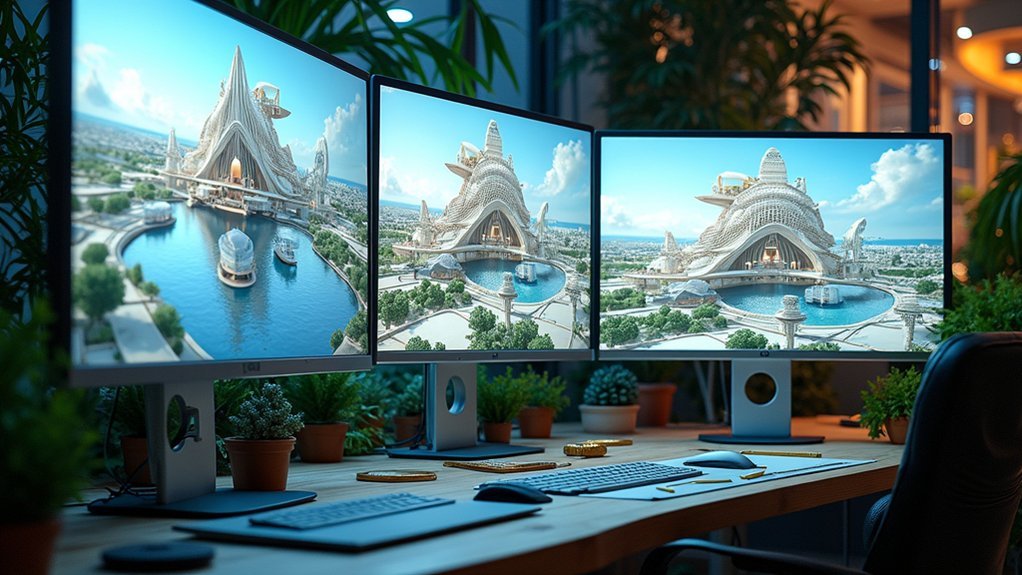


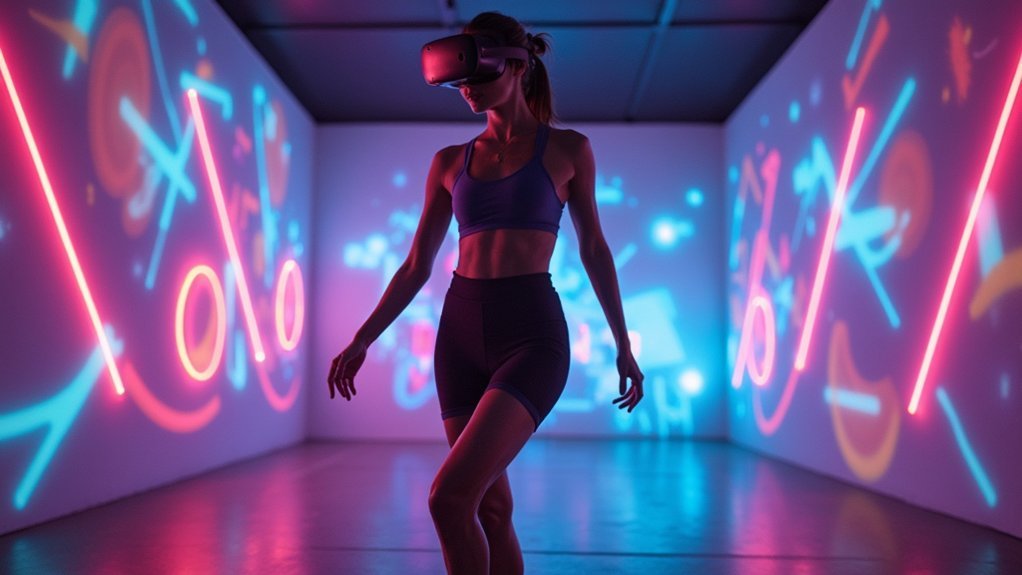
Leave a Reply